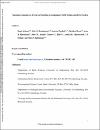Vegetation responses to 26 years of warming at Latnjajaure Field Station, northern Sweden
| Author | Scharn, Ruud |
| Author | Brachmann, Cole G. |
| Author | Patchett, Aurora |
| Author | Reese, Heather |
| Author | Bjorkman, Anne |
| Author | Alatalo, Juha |
| Author | Björk, Robert G. |
| Author | Jägerbrand, Annika K. |
| Author | Molau, Ulf |
| Author | Björkman, Mats P. |
| Available date | 2021-07-13T10:43:38Z |
| Publication Date | 2021-04-01 |
| Publication Name | Arctic Science |
| Identifier | http://dx.doi.org/10.1139/AS-2020-0042 |
| Citation | Mr. Ruud Scharn, Mr. Cole G. Brachmann, Ms. Aurora Patchett, Dr. Heather Reese, Dr. Anne Bjorkman, Dr. Juha Alatalo, Dr. Robert G. Björk, Dr. Annika K. Jägerbrand, Dr. Ulf Molau, and Dr. Mats P. Björkman. Vegetation responses to 26 years of warming at Latnjajaure Field Station, northern Sweden.. Arctic Science. Just-IN https://doi.org/10.1139/AS-2020-0042 |
| Abstract | Climate change is rapidly warming high latitude and high elevation regions influencing plant community composition. Changes in vegetation composition have motivated the coordination of ecological monitoring networks across the Arctic, including the International Tundra Experiment (ITEX). We have established a long-term passive warming experiment using open-top chambers, which includes five distinct plant communities (Dry Heath; Tussock Tundra; and Dry, Mesic, and Wet Meadow). We have measured changes in plant community composition based on relative abundance differences over 26 years. In addition, relative abundance changes in response to fertilization and warming treatments were analysed based on a 7-year Community-Level Interaction Program (CLIP) experiment. The communities had distinct soil moisture conditions, leading to community specific responses of the plant growth forms (deciduous shrubs, evergreen shrubs, forbs and graminoids). Warming significantly affected growth forms, but the direction of the response was not consistent across the communities. Evidence of shrub expansion was found in nearly all communities, with soil moisture determining whether it was driven by deciduous or evergreen shrubs. Graminoids increased in relative abundance in the Dry Meadow due to warming. Growth form responses to warming are likely mediated by edaphic characteristics of the communities and their interactions with climate. |
| Language | en |
| Publisher | NRC Research Press |
| Subject | Climate change Sweden vegetation composition warming |
| Type | Article |
| ESSN | 2368-7460 |
Files in this item
This item appears in the following Collection(s)
-
Earth Science Cluster [217 items ]


